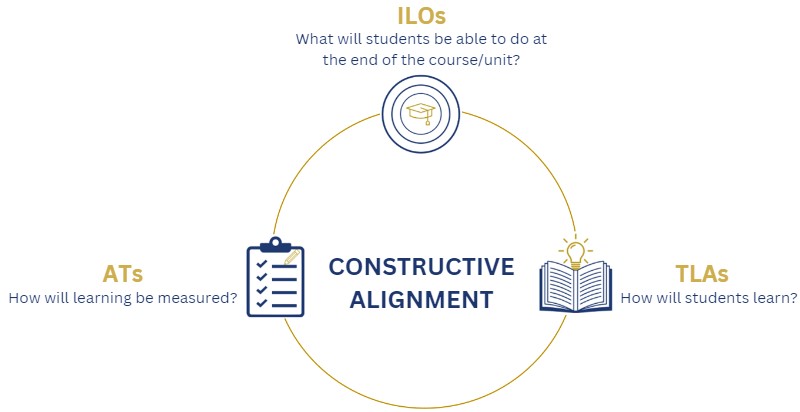Effective teaching and learning in the field of medical education depends on aligning what students learn with how they are assessed. This premise is emphasized by Biggs (1996) in his work on constructive alignment and it is supported by various researchers in the field of Higher Education. Constructive alignment plays a vital role in ensuring that assessments accurately measure the skills and knowledge required of future healthcare professionals (Shumway & Harden, 2003). By aligning these elements, educators can not only evaluate student performance more effectively but also enhance learning by encouraging deep engagement with the material.
This article is part of a series focused on assessment in Higher Education. You can find the first part here.
What is constructive alignment?
According to Biggs, Tang, & Kennedy, (2022), „constructive” is derived from the constructivist theory, which argues that students build their own knowledge by applying previously taught structures and concepts to interpret new information. „Alignment” is a concept of curricular theory that states that assessment tasks must correspond to the content being taught. The three main components of constructive alignment (CA) are the intended learning outcomes (ILOs), teaching and learning activities (TLAs) and assessment tasks (ATs). When teaching is aligned, it tends to be more effective than when it is not, since the system has optimal consistency.
Constructive alignment starts with identifying ILOs. These outcomes are written using specific action verbs that describe what we want students to do, like „explain,” „analyze,” or „demonstrate.” These verbs represent the skills and actions that students need to perform within the context of the unit or the subject. Once the ILOs are defined, the next step is designing TLAs that encourage students to practice and engage with those verbs. For example, if the ILO is for students to „analyze” a case study, the TLA might involve group discussions, problem-solving exercises, or debates that encourage critical thinking and in-depth exploration of the case. The idea is that when students actively engage with the verbs in the ILOs, they are more likely to achieve the desired outcomes.
Finally, the ATs are selected to measure whether students have achieved the ILOs. The assessments should directly reflect the verbs in the ILOs and give students an opportunity to demonstrate their understanding. For instance, if the ILO asks students to „analyze” a case study, then the assessment could involve asking students to critically examine a new case study and identify key issues, draw conclusions, and propose solutions. This ensures that the assessment aligns with the learning outcome by requiring students to apply the analytical skills they have developed. The assessments tell us whether and how well each student has met the criteria set out in the ILOs (Biggs, Tang, & Kennedy, 2022).

Figure 1. Constructive alignment as a holistic interactive system. Adapted from Biggs, Tang, & Kennedy, (2022)
Practical examples in medical education
As suggested by Shumway & Harden (2003), in medical education, where assessing skills such as problem-solving, critical thinking, and decision-making is essential, CA can be an effective tool for educators. Take the example of an ILO that expects students to demonstrate competence in analyzing patient case studies. To align this outcome with TLAs, educators might design activities where students work in groups to break down real-life case scenarios, discussing possible diagnoses and treatment plans. For the AT, students might be required to individually analyze a new case and write a report that showcases their ability to apply medical knowledge critically and draw evidence-based conclusions.
These activities and assessments align with the ILO because they both focus on the analytical skills necessary for diagnosing patients in clinical settings. By integrating the learning and assessment into the teaching process, CA ensures that students are consistently engaging with the core competencies they need to master (Biggs, Tang, & Kennedy, 2022).
When designing an assessment program, it is essential for educators to be familiar with the concept of ILOs and the various assessment methods that can be used to measure them. This knowledge allows them to select the most suitable tools for evaluating student performance. Additionally, a deep understanding of the assessment process is necessary to ensure that the chosen methods are implemented effectively in practice. Educators must also be able to assess the strengths and limitations of different assessment tools and determine how well they align with the learning outcomes and teaching context (Shumway & Harden, 2003).
Challenges and benefits of implementing constructive alignment
While the benefits of CA are clear, its implementation is not without challenges. One of the primary difficulties is a lack of understanding among educators about how to design aligned courses. Additionally, aligning assessments with higher-order thinking skills (such as analysis, synthesis, and evaluation) can be difficult to measure objectively (Harden & Laidlaw, 2013).
However, the benefits of CA make overcoming these challenges worthwhile. When teaching, learning activities, and assessments are aligned, students are more likely to engage deeply with the material, resulting in more meaningful learning experiences. Moreover, aligned assessments provide clear criteria for success, helping students understand the expectations and focus their efforts accordingly (Shumway & Harden, 2003). For educators, CA provides a structured approach to curriculum design that supports both formative and summative assessment processes, ensuring that learning outcomes are met consistently across the program.
References
Biggs, J. (1996). Enhancing teaching through constructive alignment. Higher Education, 32(3), 347-364.
Biggs, J., Tang, C., & Kennedy, G. (2022). Teaching for quality learning at university 5e. McGraw-Hill education (UK).
Harden, R. M., & Laidlaw, J. M. (2013). Essential Skills for a Medical Teacher: An Introduction to Teaching and Learning in Medicine. Elsevier.
Liaqat Ali (2018). The Design of Curriculum, Assessment and Evaluation in Higher Education with Constructive Alignment. Journal of Education and e-Learning Research, 5(1): 72-78.
Shumway, James M., and Ronald M. Harden. „AMEE Guide No. 25: The assessment of learning outcomes for the competent and reflective physician.” Medical teacher 25.6 (2003): 569-584.